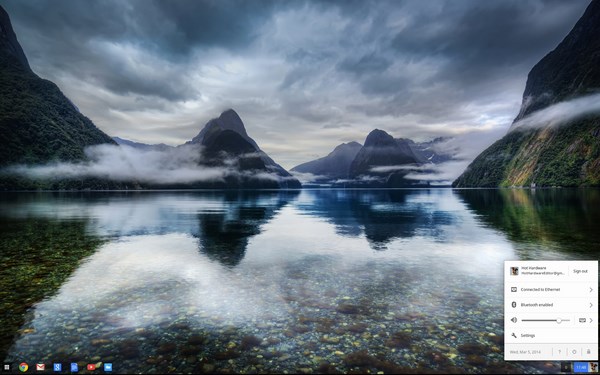ASUS Chromebox Google Chrome OS SFF PC Review
Software and User Experience
The Chrome OS itself is about as clean and stripped of clutter as you've ever experienced on any platform. A simple menu on the left bottom corner of the home screen offers you access to all your programs while the task bar can have shortcuts pinned to it for your favorite apps.








The bottom right corner of the screen houses the user control panel where you can access quick preferences for wireless network settings, Bluetooth, volume, main system settings, date and time, and the software power and lock buttons.




In the main settings control panel you can find settings for changing desktop wall paper, date and time, font scaling, wake and sleep control, synch settings, passwords and forms, and a host of other settings, including the ability to reset the system and remove all accounts and data with the “Powerwash” function button.

Google's office apps suite is here with Sheets for Excel-like documents, Docs for word processing, and Slides for PowerPoint-like presentation creation. You also get a host of other Google apps pre-installed like Calendar, Google Maps, and YouTube.


The Files app is where you can browse all the files on the system or in your Google Drive account, with which, again, Google gives you 100 Gigabytes of free cloud storage for 2 years. With the Files app you can browse and access your Drive account data, shared data from Google apps, and offline data and files that are stored locally on the Chromebox itself.


In terms of apps on Google's Chrome store (seen above), there are two general classes of apps you’ll find: Online apps, which are essentially just internet shortcuts to online third party apps, games, and utilities that have been qualified to work with Chrome OS and the Chrome browser, and offline apps, which actually install on the machine and do not need an internet connection to run (even though they also run in the Chrome browser). The Google office apps suite of Docs, Sheets, and Slides are examples of apps that can run in offline mode. Pandora, Spotify, and Netflix are a few of our favorites that are present here as well, but in reality they're nothing more than internet shortcuts that take you to these respective services online. That said, we had no problem running any of them quickly and easily, logging in via the Chrome web browser and streaming music or HD video.

The multi-window view seen above is a nice way to leave a few apps or sites running and switch between them quickly while still having access to quick-glance information elsewhere in apps that are in the background on the grid. This view automatically organizes your active apps neatly on the desktop. Let's dig into some offline apps next...








